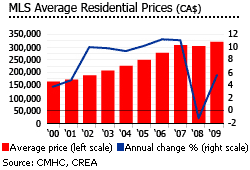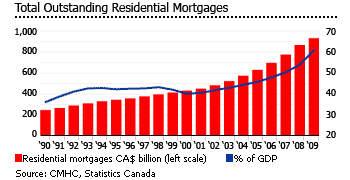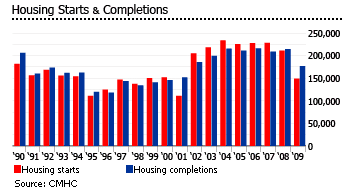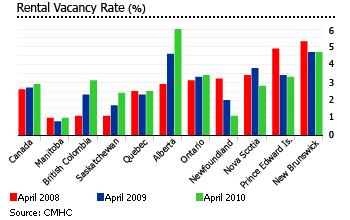Canadian housing slowdown
Canada’s house prices are stagnating, after moving strongly up in 2009. Despite record low mortgage rates, stricter policies, new sales taxes, and interest rate hikes are calming the market –
- New mortgage policies implemented since April 19, 2010, have made it more difficult for borrowers to qualify for mortgages with loan terms of four years or less.
- Yet interest rates on five-year fixed-rate mortgages are much higher, than on short-term mortgages.
- A new sales tax, the Harmonized Sales Tax (HST), was implemented in British Columbia and Ontario. New houses will be subject to an additional 5% General Sales Tax on top of the Provincial Sales Tax at 8% in Ontario, and 7% in British Columbia.
- The key rate was raised 25 basis points to 1% in early-September by the Bank of Canada (BoC), the third consecutive rate hike since June 2010. While the impact on the mortgage market has so far been minimal, the longer term message is clear.
The housing market is likely to continue slowing in the second half of 2010. Average residential resale prices are projected to rise just 1.6% in 2010, with gains in all provinces’ expected moderate, according to the Canadian Real Estate Association (CREA).

During the crisis, Canada’s conservative lending practices, once considered a weakness, helped it avoid contagion from the US. Canada’s domestic mortgage market grew from 53.9% of GDP in 2008 to 60.8% of GDP in 2009, according to Statistics Canada.
In 2008 house prices fell 1.2%, according CREA.
In 2009, the average resale house prices rose 5.5%.
In July 2010, prices for existing MLS homes were up a mere 1% from a year earlier to CA$330,351 (US$139,087).
Eastern seaboard trumps the rest
The highest house price rises took place in the small eastern province of Newfoundland and Labrador, up 16.2% during the year to July 2010, due to construction projects in minerals and energy. They were followed by Manitoba, where house prices rose 9.4% over the same period.
Strong rises also occurred in Saskatchewan (6.6%), Quebec (6.5%), and British Columbia (6%).
Canada’s most expensive houses
Canada’s most expensive housing is in British Columbia, with existing homes’ average prices CA$491,832 (US$475,062) in July 2010.
Alberta and Ontario followed with average resale prices of CA$355,295 (US$343,181) and CA$328,851 (US$317,638).
In July 2010, Prince Edward Is. had the cheapest houses in Canada, with average prices of CA$144,770 (US$139,834).
Change title of this chart below to RESIDENTIAL RESALE PRICE TRENDS
MLS® AVERAGE RESIDENTIAL RESALE PRICE |
||||||
| |
|
|||||
| |
|
|||||
| |
|
|
||||
| |
|
|
||||
| |
|
|
||||
| |
||||||
| |
|
|
|
|||
| |
||||||
| Source: Canadian Real Estate Association | ||||||
Mortgage interest rates at historic lows!

The key interest rate was raised by 25 basis points to 1% in early-September 2010, the third consecutive rate hike since June 2010.
Despite the key rate hikes, actual mortgage rates are at historic lows.
- The 1-year mortgage rate fell to 3.3% in August 2010, from 6.65% in August 2008.
- Interest rates on 3-year mortgages moved to 4.1% in August 2010, from 6.7% in the previous two years.
- The 5-year mortgage rate moved to 5.4% in August 2010, from 6.85% two year earlier.

With the economy still weak, further rate hikes will most likely be put on hold until late this year, or early-2011.
The BoC reduced the key rate six times in 2008, from 4% in January to 1.5% in December, following interest rate cuts in the US. Then the target rate was reduced three times more in 2009, to a record low of 0.25%, where it remained from April 2009 to May 2010.
Existing home sales expected to decline

Existing home sales are expected to fall 1.7% to 456,000 units in 2011, according to the Canadian Mortgage and Housing Corporation (CMHC).
In 2009, total MLS existing home sales were up 7.2% on the previous year, with British Columbia and Ontario leading the increase.
Sales of existing homes in Canada peaked in 2007, when 520,747 housing units were sold.

Housing starts plunged 29% in 2009 to 149,081 units, according to CMHC. From 2002 to 2008, housing units started in Canada averaged 221,309 units per year. Completions also fell, by 18% in 2009, to 176,441 units. The average number of housing units completed from 2002 to 2008 was 207,244 units per year.
New house prices fall!

The new housing price index (NHPI) fell 0.1% in July 2010 from the previous month, the first monthly drop in the last 13 months, according to Statistics Canada. The top contributors of the monthly decrease were cities in Ontario and British Columbia.
The NHPI rose 2.9% in July 2010 from a year earlier, or 1.1% when adjusted for inflation.
Rental market is stable

Rents rose by 1.8% nationally in the year to April 2010, according to CMHC. Rents for two-bedroom apartments rose in all provinces, except in Alberta and British Columbia.
Between 1998 and 2008, average rents for two-bedroom units rose by 30.5%.
Alberta has the most expensive rental properties, with average monthly rents of CA$1,023 (US$988) for a two-bedroom apartment; followed by British Columbia, CA$983 (US$949) per month; and Ontario CA$978 (US$945) per month.
Among all the provinces, Newfoundland and Labrador offer the lowest rents for two-bedroom apartments at CA$640 (US$618) per month.
Rental yields in Montreal are attractive at between 5.9% to 8.4% on small apartments, according to the latest Global Property Guide research conducted in January 2010.
In April 2010, vacancy rates in Canada rose to 2.9% from 2.7% from a year earlier, according to CMHC. Alberta has the highest vacancy rate at 6% while Manitoba has the lowest, at 1%.
Economic growth of 3.3% expected in 2010

After a beginning-of-year growth spurt, the Canadian economy grew at an annualized rate of 2% in Q2 2010, down from 5.8% GDP growth in Q1 2010. Canada’s GDP is projected to grow 3.3% in 2010.
The slowdown was due to the widening trade gap, slower consumer expenditure growth, lower business investment on residential buildings, and the decline in the home resale market.
The Canadian economy shrank 2.7% in 2009, after 0.4% GDP growth in 2008. Average annual GDP growth from 1992 to 2007 was 3%.
By the end of 2010, unemployment is expected to fall from the present 8.1% be around 7.9%, according to the OECD.
In July 2010, trade deficit widened to a record CA$2.74 billion (US$2.66 billion), the biggest gap in the last four decades, as exports to the US fell.
In June 2010, the budget deficit was CA$2.8 billion (US$2.7 billion), compared with CA$5 billion (US$4.85 billion) from the same month last year. The lower deficit was due to lower spending on transfer payments like employment insurance and aid for the automotive industry, which has been provided during the global crisis. The federal budget deficit was projected at CA$49.2 billion (US$47.5 billion), or more than 3% of GDP in 2010.